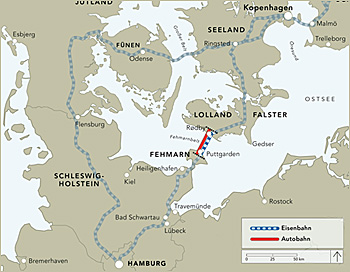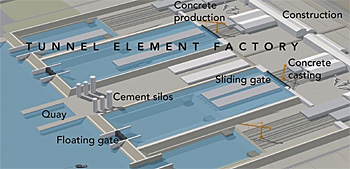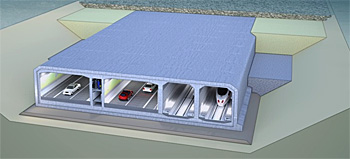BAM consortium prequalified for main construction Fehmarnbelt tunnel, Denmark

Danish planning company Femern has announced that the Danish political parties behind the Fehmarnbelt link, mandated the appointment of the preferred bidders for the main tunnel contracts with the aim of entering conditional contracts no later than mid-May 2016.
Dutch civil engineering construction firm BAM is partner in the consortium Femern Link Contractors (FLC), which will be responsible for the immersed tunnel and tunnel factory, as well as for the portals and ramps.
 The Fehmarn tunnel is to link the German Fehmarn island and the Danish Lolland island by 2024.
The Fehmarn tunnel is to link the German Fehmarn island and the Danish Lolland island by 2024.
The Fehmarnbelt tunnel is to connect Denmark and Germany with a 18 km long immersed tunnel link, carring a four-lane motorway alongside a twin track-electrified railway.
The total budget for the Fehmarnbelt link construction is 6 billion euro and the value of the contract to Boskalis is 300 million euro.
Femern is a subsidiary of the Danish state-owned Sund & Bælt Holding and is charged with preparing the construction of the tunnel.
Preferred bidder for two contracts
The consortium Femern Link Contractors is a preferred bidder for two contracts. One contract is for the factory that constructs the tunnel elements and the construction of the immersed tunnel.
The other contract is for connecting roads and rail to the existing networks.
 Impression of the factory where 89 elements will be constructed.
Impression of the factory where 89 elements will be constructed.
Factory for prefab tunnel elements
The immersed tunnel will comprise 89 elements made of reinforced concrete at a factory in Rødbyhavn, Denmark.
There are two types of tunnel elements: 79 standard elements and 10 special elements.
The special elements will have a special ’basement’ for machinery, which will make the construction process and maintenance of the finished tunnel easier.
The tunnel elements will be manufactured using industrial batch production, which will streamline the process considerably.
 Impression of the positioning of the tunnel elements in the trench.
Impression of the positioning of the tunnel elements in the trench.
Secure positioning on the seabed
The finished element will be sealed with a large bulkhead to enable it to float and then pushed into a specially designed basin near the factory.
From here, the element will be towed out to the Fehmarnbelt and placed into position. Here, the element will be carefully lowered into a dredged trench on the seabed.
The elements will be covered with gravel, sand and stone as they are linked together. The top layer of stone will be more or less level with the existing seabed.
Third main contract
The preferred bidder of a third major contract is the Fehmarn Belt Contractors consortium, including Royal Boskalis, Hochtief, Ed Züblin and Van Oord.
This contract concerns the dredging of a 40 m wide, 15 m deep and 18 km long trench in the seabed.
This news item was originally published on the website of BAM and Femern.
Read also on this website
● Boskalis consortium preferred bidder for dredging seabed Fehmarnbelt tunnel, Denmark, 4 March 2016
● Rijkswaterstaat announces intention to award construction new sea lock at IJmuiden, the Netherlands, 20 July 2015
● BAM wins 346 million euro contract to build fifth lock at Brunsbüttel, Germany, 29 April 2014
More information
Royal BAM Group
Bunnik, the Netherlands
+31 30 659 89 88
www.bam.eu
Impression of the construction, transport and immersion of the tunnel elements on the prepared seabed.



